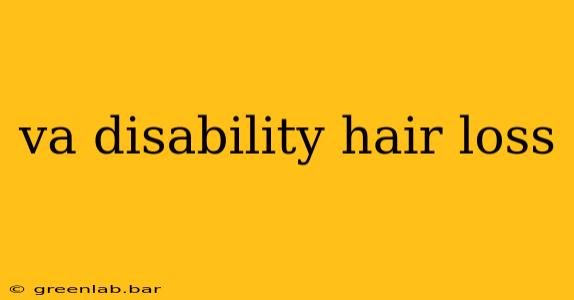Hair loss, or alopecia, can be a devastating condition impacting self-esteem and quality of life. For veterans experiencing hair loss, understanding whether it's eligible for VA disability benefits is crucial. This guide provides a comprehensive overview of the process, outlining the requirements and steps involved in filing a successful claim.
Understanding VA Disability Ratings for Hair Loss
The Department of Veterans Affairs (VA) recognizes hair loss as a potentially service-connected disability, but it's important to understand that not all hair loss qualifies. The VA requires a direct and proximate link between the hair loss and a service-connected event, injury, or illness. This means the hair loss must be a result of a condition caused or aggravated during your military service.
Key factors considered for VA disability rating for hair loss include:
-
Underlying Cause: The specific medical condition causing the hair loss is critical. Common service-connected conditions that can lead to hair loss include:
- Traumatic Brain Injury (TBI): A TBI sustained during service can result in various neurological complications, including alopecia.
- Burn Injuries: Severe burns often cause significant scarring and hair loss in affected areas.
- Exposure to Certain Chemicals or Toxins: Exposure to hazardous materials during service can trigger autoimmune disorders that lead to hair loss.
- Skin Conditions: Conditions like psoriasis or eczema, exacerbated or caused by service, can contribute to hair loss.
- Stress and PTSD: While not a direct cause, the prolonged stress and trauma associated with PTSD can sometimes contribute to hair loss conditions. This connection requires strong medical evidence.
-
Medical Evidence: A strong claim relies heavily on compelling medical evidence. This includes:
- Medical records from your time in service: Documenting any initial signs of hair loss or relevant conditions during your military service is crucial.
- Medical records from post-service care: These records should detail the diagnosis, treatment, and progression of your hair loss condition. They should clearly link the hair loss to a service-connected condition.
- Statements from medical professionals: A letter from your physician or dermatologist explicitly stating the connection between your hair loss and a service-connected event is vital.
- Lay statements: While not as impactful as medical evidence, statements from family members or friends who witnessed the onset or progression of your hair loss can provide supportive context.
-
Severity of Hair Loss: The VA will assess the extent and severity of your hair loss to determine a disability rating. This rating will fall under the appropriate diagnostic code and is based on the impact on your daily life.
Filing a VA Disability Claim for Hair Loss
The process of filing a claim involves several key steps:
- Gather your medical evidence: Collect all relevant medical records, physician statements, and any supporting documentation.
- Complete VA Form 21-526EZ: This is the standard application form for disability benefits. Ensure you accurately and thoroughly complete all sections.
- Submit your claim: You can submit your claim online through the VA eBenefits portal, by mail, or in person at a VA regional office.
- Follow up on your claim: The VA processing time can vary. Regularly check your eBenefits account for updates.
Challenges and Considerations
- Establishing a clear link: The biggest hurdle is proving the direct connection between your hair loss and a service-connected event or condition.
- Secondary conditions: If your hair loss is due to a secondary condition (such as a medication side effect related to a service-connected injury), this connection must be clearly established.
- C&P exams: The VA may require a Compensable and Pension (C&P) examination to independently evaluate your condition.
Conclusion
Securing VA disability benefits for hair loss requires meticulous documentation and a clear understanding of the VA's requirements. A strong claim hinges on providing irrefutable medical evidence that directly links your hair loss to a service-connected condition. While the process can be complex, persistence and careful preparation significantly increase your chances of success. Consulting with a veterans' service organization or experienced VA disability attorney can prove invaluable throughout the claim process. Remember, your service and well-being matter. Don't hesitate to seek the support you deserve.

